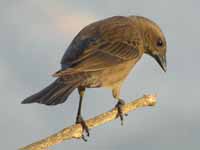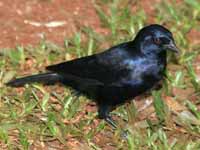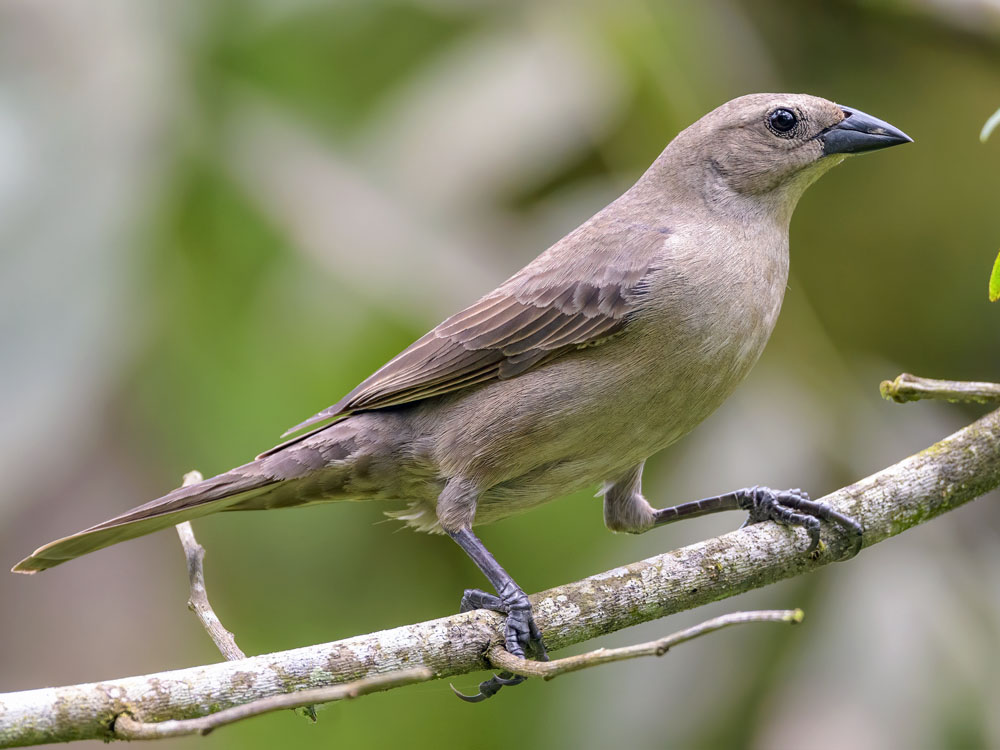THE WORLD BIRDS - An Online Bird Book
ICTERIDAE
Cowbirds
Order Passeriformes Family Icteridae
ICTERIDAE
The Icterids are a group of small to medium-sized, often colorful birds, restricted to the New World. Most species have black as a predominant plumage color, often with yellow, orange or red. The majority of icterid species live in the tropics, although there are a number of temperate forms. They inhabit a range of habitats, including scrub, swamp, forest, and savannah. Temperate species are migratory. Icterids are variable in size, and often display considerable sexual dimorphism. Their size varies 15-52 cm. One unusual adaptation shared is they can open their bills strongly rather than passively, allowing them to force open gaps to obtain otherwise hidden food. Some use their gaping motion to open the skins of fruit to obtain the soft insides, and have long bills adapted to the process. Others such as cowbirds have shorter stubbier bills for crushing seeds. Orioles will drink nectar. The nesting habits of these birds are similarly variable.
The Icteridae are described in the following articles: black birds, caciques, cowbirds, grackles, meadow lark, and orioles.
The Icteridae are described in the following articles: black birds, caciques, cowbirds, grackles, meadow lark, and orioles.
Cowbirds
Order Passeriformes Family Icteridae
"True" Cowbirds belong to the genus Molothrus. They feed on mainly insects, and some species frequent cattle to feed off the insects that are stirred up by their hooves, hence their name. In addition to insects they also eat seeds, which explains why they have large bills. All except the bay-winged cowbird leave their eggs in the nest of non cowbird species. This is problematic for the host species as the cowbird chicks tend to grow faster than their "siblings" and thus can get more than their share of food. On the other hand, if the host parent removes a cowbird egg from its nest, the cowbird mother might destroy the other eggs!.
Genu Agelaioides
The subspecies Agelaioides badius fringillarius is sometimes treated as a separate species, the pale cowbird, or the pale baywing. . This has paler underparts than the grayish baywing. It is found in northeastern Brazil, where it is primarily found in the Caatinga and the northern Cerrado.
.
Cowbird, Bay-winged Agelaioides badius
Description: The bay-winged cowbird, also known as the greyish baywing, has ashy-brown upperparts with rufous wings. It has black lores. The bay-winged cowbird is about 18 cm long. The underparts are grey. Unlike the true cowbirds, this species does not lay its eggs in other's nests. In fact, the similar screaming cowbird is a brood parasite of this species!
This is facilitated by the eggs and juveniles of the screaming cowbird being almost identical in appearance to those of the bay-winged cowbird. The nests may be in palm trees, cavities, nest built by other species.
Range: Northern half of Argentina, Bolivia, Uruguay, Paraguay and southern and central Brazil, .
Habitat: Scrublands, light woodlands.
Diet: Insects such as grasshoppers and caterpillars. Also seeds.
Conservation status: Least Concern.
Image by: 1) dFaulder - Argentina 2) Charlie Westerinen - Buenos Aires, Argentina 3) Charles_Sharp - Brazil 4) Cristiano Crolle - ArgentinaRange: Northern half of Argentina, Bolivia, Uruguay, Paraguay and southern and central Brazil, .
Habitat: Scrublands, light woodlands.
Diet: Insects such as grasshoppers and caterpillars. Also seeds.
Conservation status: Least Concern.
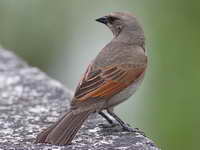
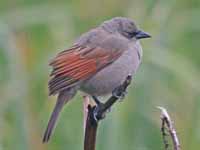

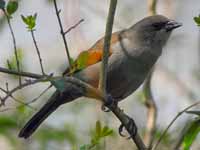
Genus Molothrus
Cowbird,_Bronzed also Red-eyed Cowbird Molothrus aeneus
Description: The male bronzed cowbird has mainly black upperparts. The wings and tail have green-bronze glossy iridescence. He has red eyes in the breeding season, otherwise they are brown. The underparts are black. He can ruff up his nape and make it appear larger. The female has blacking upperparts and brown underparts. The bronzed cowbird is about 20 cm long. The similar female Brewer's blackbird has a smaller bill. The female brown-headed cowbird has darker eyes.
The female bronze cowbird is a brood parasite of many different species. More than one cowbird may choose the same host nest. She may pierce the shell of eggs that are not hers, including eggs of other bronze cowbirds. About half the time they lay their eggs in nests of inappropriate species that are not able to provide for the cowbird's chick.
Range: Extreme southern USA, Mexico, Central America .
Habitat: Farmland, brush, and feedlots.
Diet: Insects and other arthropods, seeds. Forages on the ground.
Conservation status: Least Concern.
Image by: 1) Jerry Oldenettel - Colorado 2) Pablo Leautaud - Mexico
3)
Search Net Media - Arizona 4) Tony CastroThe female bronze cowbird is a brood parasite of many different species. More than one cowbird may choose the same host nest. She may pierce the shell of eggs that are not hers, including eggs of other bronze cowbirds. About half the time they lay their eggs in nests of inappropriate species that are not able to provide for the cowbird's chick.
Range: Extreme southern USA, Mexico, Central America .
Habitat: Farmland, brush, and feedlots.
Diet: Insects and other arthropods, seeds. Forages on the ground.
Conservation status: Least Concern.
1, 2) Female 3, 4) Male
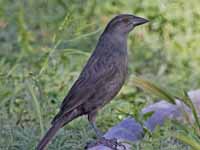
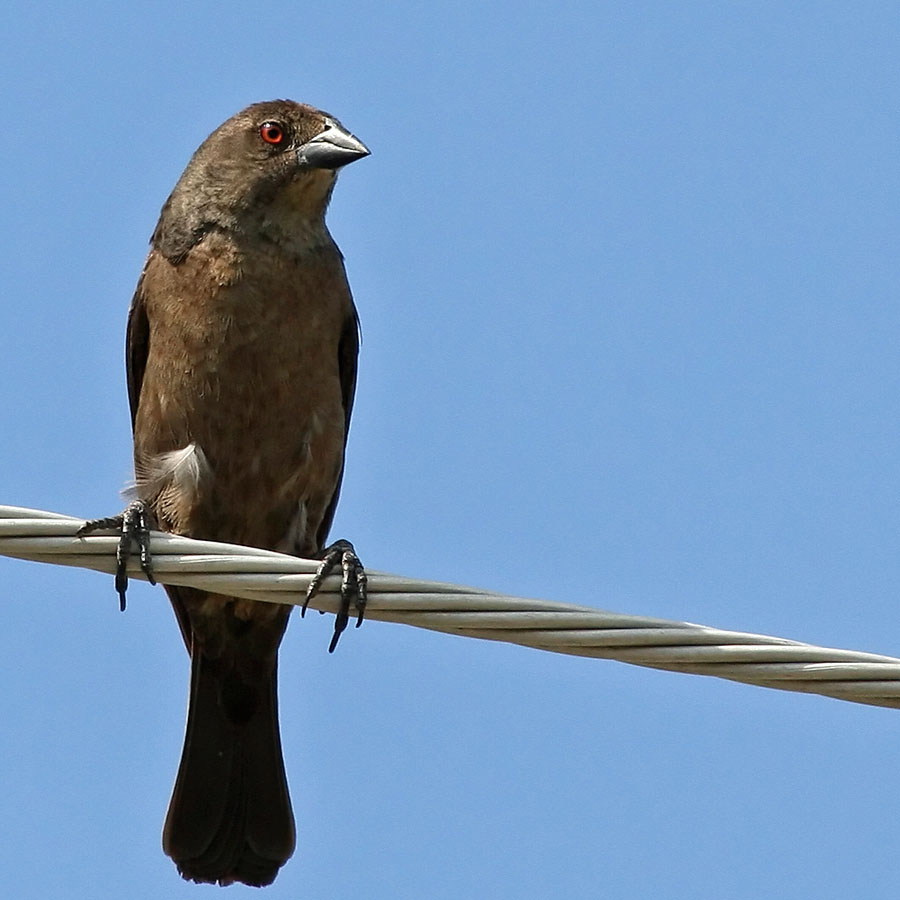
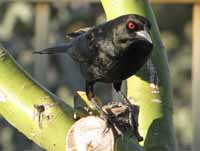
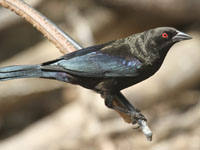
Cowbird, Brown-headed Molothrus ater
Description: The male brown-headed cowbird has mainly iridescent black plumage except for the brown head. The female is dull grey with a pale throat. The similar female Brewer's blackbird has a smaller bill; the female bronzed cowbird has lighter eyes; and the female shiny cowbird has thinner bill while the brown-headed has a more rounded head.
The brown-headed cowbird is a brood parasite and utilizes over 100 different host species. The female cowbird can reportedly lay over 20 eggs in a season. If her egg is rejected by the host, she may destroy that nest so the host will build a new one. After fledging, the juvenile brown-headed cowbird finds other cowbirds by call reconigtion.
Range: North America.
Habitat: During breeding season favors open grassy areas with a mix of trees. At other times it prefers a higher density of trees.
Diet: Seeds, insects and other arthropods.
Conservation status: Least Concern.
Image by: 1) Dick Daniels - Massachuestts 2, 3,) Dick - North Carolina 4) Alan D. Wilson - British Columbia The brown-headed cowbird is a brood parasite and utilizes over 100 different host species. The female cowbird can reportedly lay over 20 eggs in a season. If her egg is rejected by the host, she may destroy that nest so the host will build a new one. After fledging, the juvenile brown-headed cowbird finds other cowbirds by call reconigtion.
Range: North America.
Habitat: During breeding season favors open grassy areas with a mix of trees. At other times it prefers a higher density of trees.
Diet: Seeds, insects and other arthropods.
Conservation status: Least Concern.
1) Juvenile 2) Female 3, 4) Male
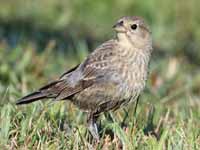
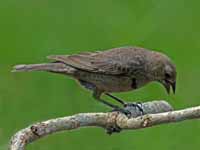
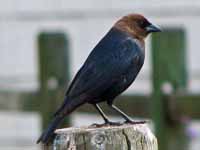
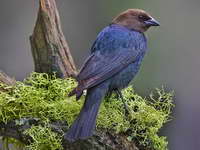
Cowbird,_Giant Molothrus oryzivorus
Description: The giant cowbird has iridescent black plumage. The head looks relatively small for the body and it has a square-ended tail. It has yellow eye and a massive black bill. The female is not as shiny as the female. It is brood parasitic, but does not destroy host eggs or chicks. It lays its eggs in nests of oropendolas and caciques. The giant cowbird is much larger than any other cowbird species. The male averages 36 cm long and the female 28 cm.
Range: Mexico, Central and South America. The range does not extend to southern South America.
Habitat: Forest, open woodland, cultivated areas with large trees.
Diet: Insects, seeds including rice. Forages on the ground or in trees.
Conservation status: Least Concern.
Image by: 1) Atastair Rae 2) Claudio_Timm 3) Nick_Athanas - Brazil 4) Francesco_Veronesi - BrazilRange: Mexico, Central and South America. The range does not extend to southern South America.
Habitat: Forest, open woodland, cultivated areas with large trees.
Diet: Insects, seeds including rice. Forages on the ground or in trees.
Conservation status: Least Concern.
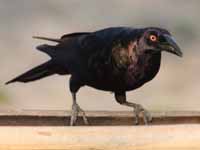

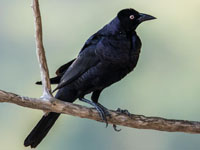
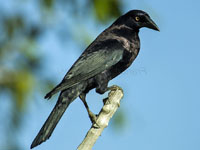
Cowbird,_Screaming Molothrus rufoaxillaris
Description: The screaming cowbird has black plumage with slightly greenish-blue sheen. The bill and legs are also black; the eyes are reddish-brown. It has a slightly forked tail. As would be expected from its name, one of its call is loud and high pitched. The screaming cowbird is 18 to 21 cm long.
It is brood parasitic with the greyish baywing. This is facilitated by the eggs and juveniles of the screaming cowbird being almost identical in appearance to those of the greyish baywing and they remain similar until after the chicks have fledged. The host very often will ejected the foreign egg. The screaming chicks are louder than the host chicks and thus more likely to receive adequate food. The screaming cowbird also is brood parasitic of the chopi blackbird and the brown-and-yellow marshbird, but much less frequently than the bay-winged cowbird. These hosts are not known to ejected the host eggs. The shining cowbird does not seem to be parasitic with the pale baywing, even though it used to be conspecific with the greyish baywing.
Range: Argentina, Bolivia, Brazil, Paraguay, and Uruguay. The range is mainly south of the giant cowbird's range.
Habitat: Pastures where it forages among the cattle, hence the cowbird name.
Diet: Insects and other invertebrate. It will forage on the ground close to cattle to gather the arthropods that have been disturbed by cattle.
Conservation status: Least Concern.
Image by: 1, 2) Claudio Timm -
Brazil 3) Lip Kee - Argentina 4) Nick_Athanas - ArgentinaIt is brood parasitic with the greyish baywing. This is facilitated by the eggs and juveniles of the screaming cowbird being almost identical in appearance to those of the greyish baywing and they remain similar until after the chicks have fledged. The host very often will ejected the foreign egg. The screaming chicks are louder than the host chicks and thus more likely to receive adequate food. The screaming cowbird also is brood parasitic of the chopi blackbird and the brown-and-yellow marshbird, but much less frequently than the bay-winged cowbird. These hosts are not known to ejected the host eggs. The shining cowbird does not seem to be parasitic with the pale baywing, even though it used to be conspecific with the greyish baywing.
Range: Argentina, Bolivia, Brazil, Paraguay, and Uruguay. The range is mainly south of the giant cowbird's range.
Habitat: Pastures where it forages among the cattle, hence the cowbird name.
Diet: Insects and other invertebrate. It will forage on the ground close to cattle to gather the arthropods that have been disturbed by cattle.
Conservation status: Least Concern.
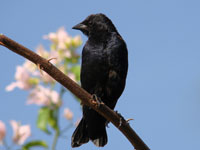
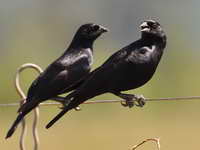
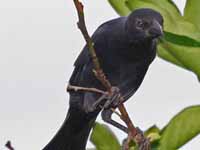
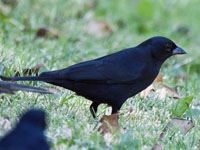
Cowbird, Shiny Molothrus bonariensis
Description: The male shiny cowbird is iridescent blue-purple-black. The female has brown plumage, which is lighter on the underparts. She has a pale supercilium. They have a flater head then other cowbirds and also a relatively thin bill. The shiny cowbird is 18 to 22 cm long depending on the subspecies.
It is brood parasitic and is the South American equivalent of the brown-headed cowbird in its use of diverse hosts. The shiny cowbird has been recorded as utilizing over 70 different species of hosts. It population is spreading northward and has arrived in Florida. There are concerns that extending its brood parasitism to new species may put the populations in danger.
The similar female Brewer's blackbird can be distinguished by its yellow eyes; the female by its smaller bill. The male bronzed cowbird has red eyes[ the female has greyer plumage. The male brown-headed cowbird is distinguished by its brown head; the female by its thicker bill and more rounded head. The female shiny cowbird has a longer finer bill and a pale supercilium compared to the female chestnut-capped blackbird.
Range: South North America to south South America.
Habitat: Open areas including disturbed land from agriculture and deforestation.
Diet: Mainly insects; also seeds.
Conservation status: Least Concern.
Image by: 1, 2) Barloventomagico - Venezuela 3) Dick - Lima, Peru 4) Lip Kee - ArgentinaIt is brood parasitic and is the South American equivalent of the brown-headed cowbird in its use of diverse hosts. The shiny cowbird has been recorded as utilizing over 70 different species of hosts. It population is spreading northward and has arrived in Florida. There are concerns that extending its brood parasitism to new species may put the populations in danger.
The similar female Brewer's blackbird can be distinguished by its yellow eyes; the female by its smaller bill. The male bronzed cowbird has red eyes[ the female has greyer plumage. The male brown-headed cowbird is distinguished by its brown head; the female by its thicker bill and more rounded head. The female shiny cowbird has a longer finer bill and a pale supercilium compared to the female chestnut-capped blackbird.
Range: South North America to south South America.
Habitat: Open areas including disturbed land from agriculture and deforestation.
Diet: Mainly insects; also seeds.
Conservation status: Least Concern.
1) Shiny Cowbird fledling raised by White-bearded Flycatcher 2) Female 3, 4) Male

